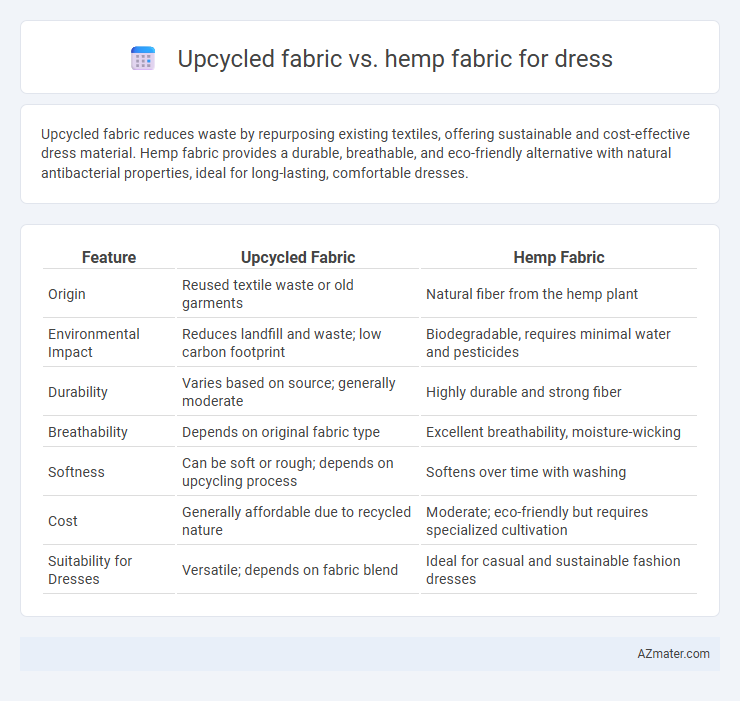Upcycled fabric reduces waste by repurposing existing textiles, offering sustainable and cost-effective dress material. Hemp fabric provides a durable, breathable, and eco-friendly alternative with natural antibacterial properties, ideal for long-lasting, comfortable dresses.
Table of Comparison
| Feature | Upcycled Fabric | Hemp Fabric |
|---|---|---|
| Origin | Reused textile waste or old garments | Natural fiber from the hemp plant |
| Environmental Impact | Reduces landfill and waste; low carbon footprint | Biodegradable, requires minimal water and pesticides |
| Durability | Varies based on source; generally moderate | Highly durable and strong fiber |
| Breathability | Depends on original fabric type | Excellent breathability, moisture-wicking |
| Softness | Can be soft or rough; depends on upcycling process | Softens over time with washing |
| Cost | Generally affordable due to recycled nature | Moderate; eco-friendly but requires specialized cultivation |
| Suitability for Dresses | Versatile; depends on fabric blend | Ideal for casual and sustainable fashion dresses |
Introduction: Upcycled Fabric vs Hemp Fabric for Dresses
Upcycled fabric for dresses involves repurposing pre-existing textiles, reducing waste, and promoting sustainable fashion by minimizing resource consumption. Hemp fabric, derived from the fast-growing hemp plant, offers durability, breathability, and natural antimicrobial properties, making it an eco-friendly choice for dress materials. Both options support sustainable clothing but differ in production impact, texture, and environmental footprint.
Sustainability Comparison: Upcycling vs Hemp Production
Upcycled fabric reduces waste by repurposing existing textiles, significantly lowering environmental impact through minimized resource consumption and landfill contributions. Hemp fabric, grown with low water and pesticide needs, promotes sustainable agriculture while offering durability and biodegradability. Comparing sustainability, upcycling leverages textile waste effectively, whereas hemp's eco-friendly cultivation ensures a renewable, long-term raw material supply for dress production.
Environmental Impact: Water Use and Carbon Footprint
Upcycled fabric significantly reduces environmental impact by repurposing existing materials, minimizing water consumption and lowering carbon emissions compared to producing new textiles. Hemp fabric requires considerably less water than conventional cotton, using up to 50% less, and has a carbon footprint that sequesters more CO2 due to the plant's rapid growth. Choosing either upcycled or hemp fabric supports sustainable fashion by reducing water use and overall greenhouse gas emissions, but upcycled materials excel in minimizing resource extraction and waste.
Material Sourcing and Availability
Upcycled fabric is sourced from pre-existing textiles, reducing waste by repurposing discarded clothing and fabric remnants, whereas hemp fabric is derived from the fibrous stalks of the hemp plant, known for its rapid growth and minimal agricultural inputs. Availability of upcycled fabric depends on the volume of textile waste and local recycling operations, resulting in variable supply, while hemp fabric benefits from increasing cultivation driven by sustainable farming trends, ensuring more consistent availability. Both materials contribute to eco-friendly fashion, but upcycled fabric emphasizes circularity, and hemp fabric highlights renewable resource use.
Durability and Longevity of Upcycled vs Hemp Dresses
Upcycled fabric offers durability by repurposing high-quality textiles that have already undergone production processes, often resulting in enhanced strength and reduced environmental impact. Hemp fabric is renowned for its exceptional toughness, resisting wear and tear through extensive fiber resilience, making hemp dresses highly durable over time. While both fabrics provide longevity, hemp's natural resistance to stretching and abrasion typically surpasses upcycled materials, ensuring longer-lasting dresses with sustainable benefits.
Aesthetic Qualities and Design Versatility
Upcycled fabric offers unique, one-of-a-kind textures and patterns that enhance a dress's individuality and appeal, making each piece distinct. Hemp fabric provides a natural, earthy aesthetic with a subtle sheen and crisp structure, ideal for minimalist or eco-conscious designs. Both materials boast design versatility, where upcycled fabric excels in bold, artistic statements and hemp fabric supports durable, breathable, and adaptable styles suitable for casual to formal wear.
Comfort and Wearability Comparison
Upcycled fabric offers unique softness and breathability due to its recycled fibers, making it comfortable for everyday wear while contributing to sustainability. Hemp fabric provides exceptional durability and natural moisture-wicking properties, ensuring breathability and comfort even in warmer climates. Both fabrics promote eco-friendly fashion, but hemp tends to be more breathable and hypoallergenic, enhancing wearability for sensitive skin.
Cost and Affordability for Consumers
Upcycled fabric often offers a more affordable option for dress materials compared to hemp fabric due to lower production costs and the reuse of existing textiles. Hemp fabric, while durable and eco-friendly, generally comes with higher prices reflecting its cultivation and processing expenses. Consumers seeking budget-friendly sustainable fashion tend to prefer upcycled fabrics for dressmaking without compromising environmental benefits.
Ethical Considerations and Social Impact
Upcycled fabric reduces textile waste by repurposing materials, minimizing environmental impact and promoting sustainable consumption in the fashion industry. Hemp fabric offers ethical benefits through its low water usage, natural pest resistance, and biodegradability, supporting eco-friendly agriculture and reducing carbon footprints. Both materials contribute to social impact by encouraging fair labor practices and fostering community-based production models in garment manufacturing.
Conclusion: Which Fabric is Best for Dresses?
Upcycled fabric offers a sustainable option by repurposing existing textiles, reducing waste and environmental impact, while hemp fabric stands out for its natural durability, breathability, and antimicrobial properties. Dresses made from hemp provide long-lasting wear and eco-friendly benefits due to its minimal water usage and biodegradability. Choosing between upcycled and hemp fabric depends on the priority between circular fashion practices and the inherent qualities of a natural fiber, with hemp generally being the best choice for sustainable, comfortable, and durable dresses.

Infographic: Upcycled fabric vs Hemp fabric for Dress
 azmater.com
azmater.com